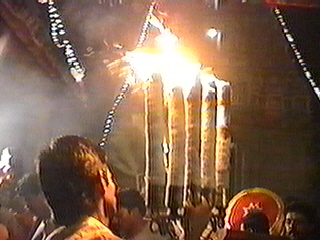Abodes of Ganesha
Temples of Tamilnadu
|

The concept of Time in Indian
Mythology
Beliefs
and Legends
Festivals celebrate the passage of time. Celebration of a new Gregorian year is just that. It is an acknowledgement of the passage of 12 months and the commencement of another. In terms of time frames our existence on this planet is but a speck in the grand scheme of creation. It was a good 400 years ago that the emperors of Vijayanagar created magnificient monuments all over south India. It was about a 1000 years ago that the Thanjavur Periya Koyil, the Hoysala monuments and other towering temples came into existence all over India. The Ellora temple even predates these. It was 1400 years ago when the Bhakti movement of south India saw the documentation of the existence of temples. It was about 2000 years ago when the Tamil Sangam literature documented the existence of places of worship such as Tiruvenkaadu. The excavated remains of Indus valley are 5000 years old.
That is a 5000 year timeline - history as we may call it. How does Indian mythology view time ? M. H. Krishnaswamy of Chennai authors this Templenet feature on 'Time - as viewed in Indian mythology'.
The smallest unit of time is a kaashta which is 18 times the amount of time it takes to blink an eyelid. 10 kaashtas make a kshanam and 12 kshanams constitute a muhoortam. 60 of these muhoortams constitute a day.
30 days constitute a month and 3 months make up a ritu. 12 months of course constitue a human year.
We now move on from the human plane to the world of the departed souls - the pitrus. Here, a human month equals the length of a day. The brighter half of a lunar month constitutes the pitru's day time and the darker half their night.
In the realm of the Devas or the Gods, a human year constitutes a single day. The brighter half of the year Uttarayanam makes up the day time hours of the Devas while the darker half Dakshinayanam makes up the night time hours.
An epoch or a yuga is the next higher level of measurement. 1200 Deva years constitute the Kaliyuga or the present epoch that we are believed to be living in; 2400 deva years make up the Dwapara yuga that preceded kali yuga; 3600 years made up the Treta yuga and 4800 the Krita yuga respectively.
Thus, the length of the Kaliyuga is 1200*360 i.e. 432,000 human years. A cycle of 4 yugas is referred to as the catur yugas. A cycle of catur yugas lasts for 12,000 deva years or 12,000* 360 i.e. 4,320,000 human years.
How do these time measurements correlate with the process of creation?Bhrahma in Indian mythology is referred to as the creator. A thousand catur yugas are said to make up the daylight hours of a single day of Bhrahma's life. Another thousand make up the night time of a single day of Bhrahma. Thus, a single day in Bhrahma's life spans 2000 * 4,320,000 ie. 8,640,000,000 human years.
360 such days, each lasting 8.6 billion years constitute a year in Bhrahma's life, which lasts for a 100 Bhrahma years. At the end of one Bhrahma's life, another starts. This cycle goes on and on.
A Bhrahma's life is also known as a Para. Each half param is referred to as a parardham. It is believed that we are currently living in the 2nd half of the life of the present Bhrahma.
It is to be noted that in the performance of Vedic rituals, the frame of time in which the ritual is being performed is specified both in macro and in micro terms, the term 'dviteeya paraardhe' (the second half of Bhrahma's term) is stated.
The reference point here is the moment of commencement of creation of the Universe by Bhrahma.
When we say 'dviteeya paraardhe', which Bhrahma are we referring to? How many Bhrahmas have preceded the current one? This specification is non existant in vedic mantras. Since the whole process is cyclical, with one Bhrahma commencing when another completes, and with this process repeating forever, there may not be any significance in stating the position of Bhrahma.
In a cyclical concept of time every starting point will have to be an ending point. If time is postulated as being linear and unidirectional there will have to be an absolute starting point for time.
This cyclical nature of time as believed in Indian mythology refers to time as 'anaadi' or that without a beginning.
Yet another measure of time is Kalpa. The puranas are named after kalpas; thus we have the matsya kalpa, koorma kalpa, lakshmi kalpa, sweta varaaha kalpa, shiva kalpa, bhrahma kalpa, vishnu kalpa and so on. Each Bhrahma's term lasts for a period of 7 kalpas. The current period in time is said to belong to the sweta varaaha kalpam, which is in the second half of the life of Bhrahma.
A kalpam or an epoch is made up of 14 manvantaras and each manvantara spans 71 caturyugas. The fourteen manvantaras are respectively swayambhuva, sawosisha, audhama, thaamasa, raivatha, sakshusha, vaivasvata, savarni, daaksha savarni, bhramha savarni, dharma savarni, rudra savarni, rouchya and bowdhya. The present kaliyuga is the 28th in the present Vaivaswata manvantara.
Sankalpam: Thus, vedic mantras pin point the time of performance of a ritual - by narrowing down from dwiteeya paraardhe (in the 2nd half of the term of Bhrahma), Sweta varaaha kalpe (in the kalpa sweta varaaha), Vaivasvata manvantare (in the 7th manvantaram), Kaliyuge (in the kali epoch) - through the finer details such as the name of the current year, month etc.
